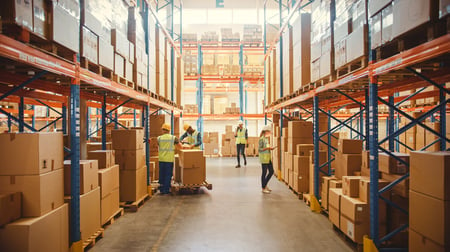 The past year has thrown material handling an incredible number of curveballs: labor issues, supply chain shortages, delayed shipping, and many others. With a new year about to ring in, many are asking what comes next.
The past year has thrown material handling an incredible number of curveballs: labor issues, supply chain shortages, delayed shipping, and many others. With a new year about to ring in, many are asking what comes next.
The short answer is no one knows for certain. The longer answer is that various trends and shifts that may point at what's to come regarding how the industry sources, stores, and moves their goods.
At Concentric, we’ve seen these trends take shape in warehouses and facilities across the US. That’s why we’ve pulled together our learnings to put together some predictions for 2022. Read on for more!
1. Supply chain challenges are here to stay (at least for the near future).
Frustrated by extended lead times, price increases, and material deficits in 2021? 2022 won't do much for your stress. While some industries will have enough product on hand to see them through the holidays, material handling operations will face ongoing headaches when it comes to procuring key assets, such as production equipment, spare parts, forklifts, semiconductors, and other operational essentials.
Why the ongoing challenges? Take your pick. For one, we are seeing a 19% increase in product shipping through the US system than in 2019. That’s a lot more product going through the same size pipes. In addition, challenges abound--from shipping port congestion to labor shortages, factory shutdowns to pandemic restrictions, as industries worldwide struggle to meet this surging demand.
Increased consumer spending is also stretching supply chains to their limit. A McKinsey & Co. report indicates Americans are intent on maintaining their high levels of spending in 2022, while a UBS survey finds that many are gearing up for major life changes (e.g., moving, vacations, having children, etc.) that will drive further purchasing activities. In short, demand for products is spiking across all industries, and everyone is waiting for their ship to come in.
2. More “last mile” options will emerge.
As you may know, the "last mile" refers to the final steps required to move a product from a warehouse to its final destination. Many players are looking to innovate this "last mile" through the use of robotics (e.g., Amazon's drones), installing warehouses in urban areas, implementing a crowd-sourced delivery model (i.e. Uber), exploring rapid order fulfillment models, or attempting a mix of various strategies. A rash of last-mile startups has also popped up. Expect to see more businesses pilot "last-mile" solutions in a bid to make up for lost time on the backend of their process.
3. Automation will pick up steam.
While it seems that some industries are suffering more from labor shortages than others, chances are good that the search for skilled talent won't become easier over the next twelve months. Many companies are turning to automation, regardless of ROI, because they have no other choice.
We already see automated technologies finding a home in the distribution, retail, and manufacturing sectors, to name a few. It's not a stretch to predict that the warehouses of the future will also be home to self-guided forklifts and other "smart" warehouse assets. The bad news? Many of the large-scale automated equipment providers are currently at max capacity and are unable to take on new clients. The good news? Startups and simpler automation options are entering the market all the time–there are many options to choose from and many teams like ours are making it easier for customers to get started, such as robotics as a service offering.
4. Supply chain KPIs will continue transitioning from efficient/effective to resilient metrics.
Moving forward, key performance indicators (KPIs) will likely focus on operational sustainability. Companies will seek to track how resilient their operations are by collecting and assessing data related to out-of-stock notifications, customer order frequency, supplier alternatives, or their ability to swap products. Performance metrics will still matter, but KPIs pertaining to a business’s agility and longer-term survival will carry more weight.
For example, when COVID hit, demand for 1-ply toilet paper (typically, for commercial buildings) went to zero, but 2-ply toilet paper (for homes) went through the roof. Those manufacturers that had production lines able to manufacture either 1- or 2-ply were able to switch their production lines and meet peak demand. Others missed out. That’s the difference between being effective and being resilient!
5. Businesses will explore innovative solutions to ease their stress.
2021 reinforced the value of embracing new or innovative material handling strategies to keep operations moving. As discussed in our October 2021 blog, 8 Questions to Help Your Material Handling Survive an Unpredictable Holiday Season, forklift lead times are out a year or more in many cases.
One way customers are addressing this is by accepting that they’ll retain forklifts for a few more years. Instead, they are rethinking their forklift power system with existing assets.
By thinking of their forklift power as its own system, customers are improving forklift operations without having to swap out equipment. This saves them from costly rentals or equipment downtime and improves the experience and safety for their operators.
“Power data can show you more than enough data to drive a forklift rotation program if you don’t have or use a forklift telematics package. We routinely help customers rotate fleets with our RAAMS® data,” explains Ryan Lynch, a Concentric vice president. “Right now, you don’t want to be putting undue strain on any one piece of equipment, so it’s a good time to take a step back and ask, ‘Are we looking at our assets from a usage standpoint and rotating them appropriately to help get us through this peak season?’”
Outsourcing equipment power solutions is proving to be another successful strategy. Through Concentric’s GuaranteedPOWER program, for example, high-velocity facilities are paired with engineering specialists who can help align their forklift power management with their business process strategies, eventually taking them out of the forklift power business and extending the life of their forklift fleet.
It doesn’t take a crystal ball to predict that 2022 will continue to challenge material handlers. The good news is there are opportunities to offload equipment power management to a third-party specialist so your team can free up the resources and talent to see your operations through.


 Ryan Lynch
Ryan Lynch
